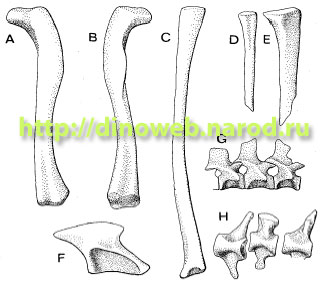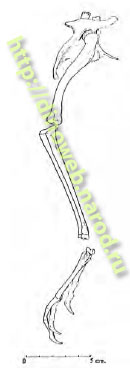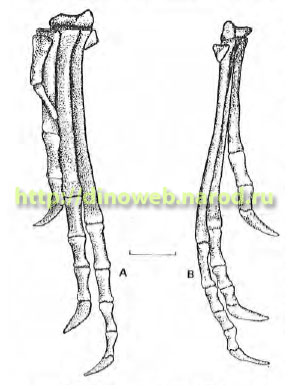
Complete Data Base of Paleozoic and Mesozoic Tetrapods.
Paleo-News and illustrations. Big electronic PDF-library.
| |
| PaleoNews |
| Classification |
| Books and Articles |
| Contact |
| Forum |
сайт о динозаврах
рейтинг сайтов
Free Counter
myspace hit counter
Lagerpeton |
Genus: Lagerpeton Romer, 1971 Classification: Archosauria - Dinosauromorpha - Lagerpetonidae Etymology: Synonyms: Type species: L. chanarensis Romer, 1971 Other Species: none Diagnosis: Species: L. chanarensis Romer, 1971 Etymology: from Los Chanares Synonyms: = Lagosuchus talampayensis Romer, 1972 (referred material) Holotype: Museo de Paleontologia, Universidad Provincal de La Rioja, la Rioja, UPLR 06 (formerly La Plata Museum no. 64-XI-14-10): Both hind legs, fragmentary humerus, articulated radius and ulna. Referred Specimens: PVL 4619: Pelvis, 2 sacral vertebrae, femur, tibia, fibula, astragalus and calcainum, 4 metatarsals, phalanges and unguals. MCZ 4121: Right femur, left femur missing distal end, fibula, partial fibula, partial tibia, right ilium, 3 dorsal and 2 sacral vertebrae. PVL 5000: Proximal left femur. Time: Ladinian, Middle Triassic. Horizon: Los Chanares Formation. Location: About 4 1/2 miles east of the mouth of Rio Chanares, La Rioja Province, Argentina. Total length: 70 cm Mass: Diagnosis: Posterior dorsal vertebrae with anteriorly-oriented neural spines. Sacrum with two vertebrae united to the ilium, the last presacral with signs of being integrated into the sacrum. Ilium with well-defined anterior projection. Well-developed supraacetabular crest as in Lagosuchus. Pubis is wide and shorter than the ischium, laminar, and with symphysis restricted to the distal portion. Ischium with extended ventral lamina, very different from Lagosuchus. Hind limb long and slender with tibia longer than the femur, and asymmetrical pes as long as the tibia. Tibia with transversely extended distal region and anterior ventral process opposite that which appears in Lagosuchus and other thecodonts. Sigmoid femur with pneumatization and well-developed fourth trochanter. Reduced fibula with developed anterolateral process. Advanced mesotarsal tarsus of dinosauroid type. Astragalus with more developed ascending process than in Lagosuchus. Calcaneum without defined tubercle. Two distal tarsals, corresponding to metatarsals III and IV. Metatarsal IV longer than the rest. Metatarsal I short and V reduced, without phalanges (Arcucci, 1986). Comments: Comparisons- (from Arcucci, 1986): Comparisons of Lagerpeton were principally with other thecodonts referred to the suborders Proterosuchia, Erythrosuchia and Pseudosuchia, excepting groups with marked divergent specializations such as Aetosauria and Phytosauria. The vertebrae of Lagerpeton show a basic morphologic type seen in primitive archosaurs such as Chasmatosaurus (Charig, 1976). They also show general similarities with those of Euparkeria and Ticinosuchus (Ewer, 1965; Krebs, 1976); nevertheless, there are differences in the height and inclination of the neural spines. There are marked differences with the short, tall vertebrae of advanced pseudosuchians such as Riojasuchus (Bonaparte, 1972). The anterior inclination of the neural spines of the last presacral vertebrae of Lagerpeton constitutes a derived feature, not observed in any other thecodont, which reveals an advanced graden of specialization in the vertebral column. The sacrum, with only two vertebrae, represents the primitive condition for the order, present in Proterosuchus, Erythrosuchus and Euparkeria (Cruickshank, 1978). An advance with respect to this condition is evident in the matter of the last presacral vertebra, which shows signs of having been integrated into the sacrum. The obviously primitive pelvis of Lagerpeton is robust and almost as wide as tall, as in proterosuchians and erythrosuchians, as distinguished from the pelves of rauisuchids and some bipedal reptiles, such as coelurosaurs and carnosaurs, which are taller than wide. However, the ilium in this genus is different from that of other primitive thecodonts due to the marked anterior extension of its iliac blade. It is oriented vertically, as in the majority of pseudosuchians, without adopting the horizontal position of the ilium of rauisuchids and aetosaurs. It has a strong supraacetabular crest, very similar to that of Lagosuchus. The pubis of Lagerpeton is short and robust, similar to that of Erythrosuchus and Euparkeria (Cruickshank, 1978; Ewer, 1965). The pubic symphysis is restricted to the distal region, with a short laminar portion, not extended like that of Gracilisuchus and Ornithosuchus. In the pubis neither the elongation nor the widening characteristic of carnosaurs (Herrerasaurus, Benedetto, 1973) is apparent, although it is outlined somewhat in Lagosuchus and thus constitutes a derivd character. The ischium is similar to that of proterosuchians and some erythrosuchians such as Chanaresuchus (Romer, 1972) in the development of a wide ventral lamina, distinguishing it from the typical cylindrical ischia of rauisuchids. Moreover, the ischium is characterized by being longer than the pubis, a feature that is also observed in primitive thecodonts (proterosuchians and erythrosuchians) and more clearly in Euparkeria (Ewer, 1965). The acetabulum is closed, not demonstrating any indications of fenestration as seen in advanced forms such as Lagosuchus, Ornithosuchus and Scleromochlus (Bonaparte, 1975; Walker, 1964; Woodward, 1907). With respect to the hind limb, due to the combination of adaptations that it presents, Lagerpeton shows great similarities with some clearly primitive thecodonts and others with dinosauroid characteristics or uncertain affinities, such as Scleromochlus. Both the femur and tibia show characters typical of advanced thecodonts (Lagosuchus) and bipedal, cursorial dinosaurs (Coelophysis, Colbert, 1964; Deinonychus, Ostrom, 1969). The indicators of pneumaticity observed in the femur of Lagerpeton are very similar to those present in forms such as Lagosuchus and some carnosaurs (Piatnitzkysaurus), although in the latter the pneumatic cavities extend to other parts of the skeleton. The tibia of Lagerpeton has other derived features, such as the fact that its distal end is transversely expanded, which is not observed in any other thecodont, and until now constituted a clearly dinosauroid character. With respect to the proximal tarsals, Lagerpeton has an advanced mesotarsal type of tarsus, only comparable to that observed in Lagosuchus and Trialestes among Comments: The morphology of the last dorsal vertebrae of Lagerpeton (length of vertebral body, anterior inclination of neural spines) indicate adaptive tendencies for increased movement of the vertebral column, supposedly related to locomotion, which have not been observed in other thecodonts and undoubtedly represent derived characters. The hind limb of Lagerpeton shows numerous apomorphic characters: short femur, longer tibia with anteriorly-directed ventral process, mesotarsal-type tarsus; while in the pes, it spite of the derived character of metatarsal elongation, note a clear asymmetry of the type seen in proterosuchians, which do not have adaptative tendencies for bipedalism. Moreover, Lagerpeton shows many important characters in the organization of the pelvis, comparable to those of a more primitive thecodont family: proterosuchids. These markedly primitive characters are: laminar ischium longer than the pubis, with a more developed ventral lamina of convex shape, pubis short and robust, with less defined symphysis. Curiously, these primitive traits are found associated with an ilium with a very developed anterior process and a strong supraacetabular crest, which are derived features generally observed at the dinosauroid level of anatomical organization. In spite of not intervening in the taxon definition, the association of primitive and derived characters in Lagerpeton is clear and determinate that the traditional concepts and interpretations of the type of structures related to different types of locomotion in archosaurs must be reconsidered and broadened. On the other hand, the retention of primitive characters in this genus indicates the relatively recent emergence of its adaptive type, and it could well be related to groups such as cerritosaurids (Chanaresuchus, Gualosuchus), contemporaries in the Los Chañares fauna. This was the basal group for a wide adaptive radiation that involvedm Lagerpeton. Although certain derived characters, comparable to those of Lagerpeton, are also observed in other pseudosuchians such as Lagosuchus, it seems probable that these similarities are due to adaptive convergences, more than due to close or ancestor-descendant relationships. Since this taxon is defined exclusively by its derived characters and these do not permit its inclusion into any of the known pseudosuchian families, the new family Lagerpetonidae is proposed for this genus. Sereno and Arcucci (1993) described the holotype and referred material of the unusual Middle Triassic dinosaur precursor, Lagerpeton chanarensis. The autapomorphies of Lagerpeton chanarensis include the convex and fluted puboischial flange, hook-shaped femoral head, elongate femoral fourth trochanter, fused astragalocalcaneum, tall posterior ascending process on the astragalus, and functionally didactyl pes. Among ornithodirans, Lagerpeton chanarensis is more closely related to dinosaurs than are pterosaurs. We list tarsal and pedal synapomorphies shared by Lagerpeton chanarensis and other dinosauromorphs that are absent in pterosaurs and crurotarsal archosaurs. These include an increase in the relative size of the central metatarsals and subparallel orientation ofpedal digit V. There is no evidence that Lagerpeton and other small-bodied dinosauromorphs in the Los Chanares fauna, namely "Lagosuchus" lilloensis, comprise a monophyletic group. The digitigrade pes and the elongate and erect hind-limbs of basal pterosaurs Lagerpeton chanarensis (estimated at 70 cm in length from the femur) is known from the complete hindlimb, pelvis, and partially articulated series of dorsal and caudal vertebrae from several specimens (Romer, 1971, 1972; Arcucci, 1986; Sereno and Arcucci, 1994b). Because of its phylogenetic placement, Lagerpeton is critical for understanding the interrelationships among dinosauromorphs and basal ornithodirans, and has been used repeatedly to polarize character states among dinosaurs. All of the aforementioned authors agree that Lagerpeton is the basal-most member of Dinosauromorpha, and the sister-taxon to Dinosauriformes. Though wellpreserved, known material of Lagerpeton lacks certain diagnostic dinosauriform character states (e.g., the presence of an anterior trochanter), thus supporting its basal position. Illustrations: Lagerpeton chanarensis. Material in nodule with the Lewisuchus type. A, Left femur in dorsal view, head restored from right femur; B, the same in ventral view; C, fibula; D, partial fibula; E, partial tibia; F, right ilium; G, dorsal vertebrae; H, presumed sacrals, in ventral view. (Sereno, P. C., and Arcucci A. B., 1993) Lagerpeton chanarensis (PVL 4619). Left lateral view of pelvis, sacrum and complete hind limb.(from Romer, A. S., 1971)
Lagerpeton chanarensis (PVL 4619). Complete left pes: A, anterior view; B, lateral view. Scale 1 cm.(from Romer, A. S., 1971)
References: Romer, A. S., 1971, The Chanares (Argentina) Triassic reptile fauna X. Two new but incompletely known long-limbed pseudosuchians: Brevoria, n. 378, p. 1-10. Romer, A. S., 1972, The Chanares (Argentina) Triassic reptile fauna. XV. Further remains of the thecodonts Lagerpeton and Lagosuchus: Breviora, n. 394, p. 1-7. Arcucci, A., 1987, Un nuevo Lagosuchidae (Thecodontia-Pseudosuchia) de la fauna de Los Chanares (Edad Reptile Chanarense, Triasic Medio), La Rioja, Argentina: Ameghiniana, v. 24, n. 1-2, p. 89-94. Sereno, P. C., and Arcucci A. B., 1993, Dinosaurian precursors from the Middle Triassic of Argentina: Lagerpeton chanarensis: Journal of Vertebrate Paleontology, v. 13, n. 4, p. 385-399. © Tetrapoda Database Roman Ulansky roman.ulansky@gmail.com or adios85@mail.ru
|



